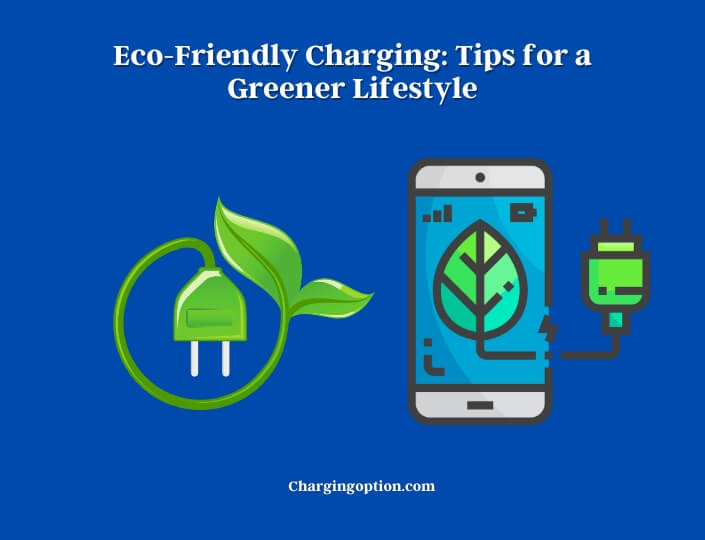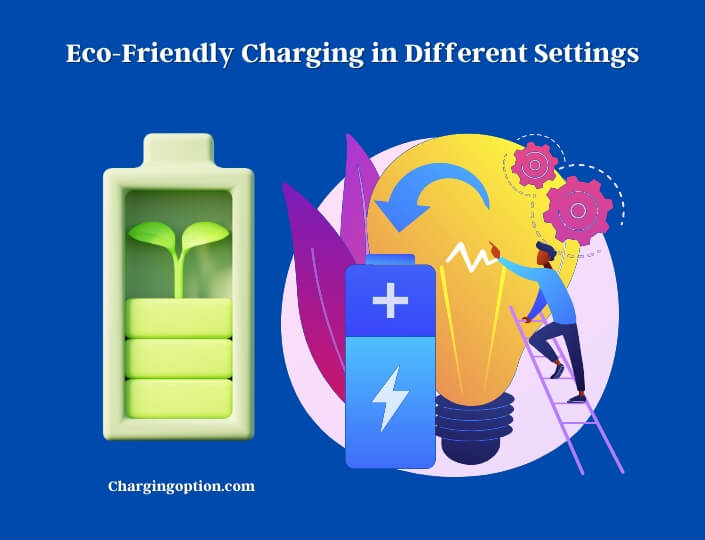With the rise of technology, we have become increasingly reliant on electronic devices. From smartphones and laptops to tablets and wearable technology, these devices have become essential parts of our daily lives.

As we continue to use them, we often overlook the environmental impact of charging these devices. The process of charging electronic devices can be incredibly energy-intensive, resulting in a significant carbon footprint that harms the environment.
The good news is that we can minimize this impact by adopting eco-friendly charging practices. By making simple changes to our charging habits and utilizing more sustainable charging solutions, we can significantly reduce our carbon footprint and help protect the planet.
Understanding the Environmental Impact of Charging
The carbon footprint of charging devices: The carbon footprint of charging devices is significant, as the energy required to charge them often comes from non-renewable sources like coal and natural gas. These sources emit greenhouse gases into the atmosphere, which contribute to climate change. The amount of carbon emitted varies depending on the type of device and the method of charging.
Energy consumption of different types of chargers: Different types of chargers have varying energy consumption levels. For instance, a wired charger connected to an outlet continuously draws power even when the device is fully charged, leading to energy waste. On the other hand, wireless chargers consume less energy because they stop charging the device when it is full. Fast chargers also consume more energy than regular chargers, leading to a larger carbon footprint.

Disposal of old chargers and electronic waste: Disposing of old chargers and electronic waste is another environmental challenge. Many old chargers end up in landfills, where they release harmful chemicals into the environment. Electronic waste contains toxic substances like lead and mercury that can harm the environment and human health.
Eco-Friendly Charging Solutions
To minimize the environmental impact of charging devices, there are several eco-friendly charging solutions available. Some of these solutions include:
Renewable Energy Sources for Charging
Using renewable energy sources like solar panels, wind turbines, or hydroelectric power to charge electronic devices is an excellent eco-friendly solution. It reduces reliance on non-renewable sources and helps minimize the carbon footprint associated with charging.
Energy-Efficient Chargers
Energy-efficient chargers consume less energy, reducing the carbon footprint associated with charging. These chargers stop drawing power once the device is fully charged, preventing energy waste.
Wireless Charging
Wireless charging is a convenient and eco-friendly solution as it consumes less energy than wired charging. It stops charging the device once it reaches full capacity, minimizing energy waste.
Smart Charging
Smart charging involves using intelligent technology to charge devices more efficiently. This technology adjusts the charging speed according to the device’s needs, reducing energy consumption and preventing overcharging.
Adopting eco-friendly charging solutions is an excellent way to reduce the environmental impact of charging devices. By using renewable energy sources and energy-efficient chargers, we can reduce our carbon footprint and help protect the planet.
Portable Chargers
Portable chargers are a useful eco-friendly solution as they allow you to charge your device on the go, without relying on an electrical outlet. Many portable chargers are now available that use renewable energy sources like solar panels to charge devices.
Battery Banks
Battery banks are an eco-friendly solution that allows you to store energy for later use. They can be charged using renewable energy sources and used to charge devices when needed. This reduces the reliance on non-renewable sources and minimizes the carbon footprint associated with charging.
Charging Stations Powered by Renewable Energy
Charging stations powered by renewable energy sources like solar or wind power are excellent eco-friendly solutions. These stations allow multiple devices to charge simultaneously using clean energy, reducing the reliance on non-renewable sources.
Charging Devices While Driving
Charging devices while driving can be an eco-friendly solution if the car uses electric power or renewable energy sources. Electric cars or hybrid cars can be used to charge devices, reducing the reliance on non-renewable sources.
Practical Tips for Eco-Friendly Charging
Adopting eco-friendly charging practices requires more than just using sustainable charging solutions. There are several practical tips you can follow to reduce your carbon footprint while charging your devices. Some of these tips include:
| Unplug chargers when not in use | Unplugging chargers from the wall when not in use can significantly reduce energy waste. Chargers continue to draw power even when the device is fully charged, leading to unnecessary energy consumption. |
| Charge devices during off-peak hours | Charging devices during off-peak hours when energy demand is lower reduces the reliance on non-renewable sources and helps minimize the carbon footprint associated with charging. |
| Charge devices to 80% | The overcharging device is a common problem that leads to energy waste. Charging devices up to 80% can significantly reduce energy waste and help extend the life of the battery. |
| Turn off devices while charging | Turning off devices while charging prevents energy waste and reduces the time it takes to charge the device. |
| Use energy-saving settings | Using energy-saving settings on devices reduces energy consumption and helps extend the battery life. |
| Avoid fast charging | Fast charging can be convenient, but it consumes more energy than regular charging, leading to a larger carbon footprint. |
Eco-Friendly Charging in Different Settings
Eco-friendly charging solutions can be implemented in different settings, including homes, offices, public places, and events. Here are some examples of how eco-friendly charging can be implemented in different settings:

Homes
In homes, renewable energy sources like solar panels can be installed to charge devices. Energy-efficient chargers can also be used, and devices can be charged during off-peak hours. Portable chargers and battery banks can be used to charge devices on the go or during power outages.
Offices
In offices, charging stations powered by renewable energy sources can be installed. Smart charging technology can be used to adjust the charging speed according to the device’s needs, reducing energy consumption. Employees can be encouraged to unplug chargers when not in use and charge devices to 80%.
Public Places
In public places like airports, charging stations powered by renewable energy sources can be installed. Wireless charging pads can also be provided, reducing energy consumption. Devices can be charged to 80%, and users can be encouraged to unplug chargers when not in use.
Events
At events, charging stations powered by renewable energy sources can be installed. Portable chargers and battery banks can also be provided for attendees to charge their devices on the go. Event organizers can encourage attendees to charge devices to 80%, use energy-efficient chargers, and unplug chargers when not in use.
Benefits of Eco-Friendly Charging
Adopting eco-friendly charging solutions and practices offers several benefits, both for the individual and the environment. Some of these benefits include:
Reduced Carbon Footprint
By using renewable energy sources and energy-efficient chargers, we can significantly reduce our carbon footprint associated with charging devices. This helps to mitigate the effects of climate change and protect the planet for future generations.
Cost Savings
Using renewable energy sources and energy-efficient chargers can result in cost savings on energy bills. Portable chargers and battery banks can also help avoid the cost of replacing device batteries.
Convenience
Eco-friendly charging solutions like portable chargers and wireless charging pads offer convenience, allowing users to charge devices on the go without relying on electrical outlets.
Extended Battery Life
Charging devices to 80% and using energy-saving settings can help extend the life of device batteries, reducing the need for frequent replacements.
Improved Air Quality
Reducing our reliance on non-renewable sources of energy reduces air pollution, improving air quality and protecting human health.
Conclusion
Eco-friendly charging solutions and practices are crucial in mitigating the effects of climate change and protecting the environment. By understanding the environmental impact of charging, adopting sustainable charging solutions, and following practical tips for eco-friendly charging, we can significantly reduce our carbon footprint associated with charging devices.
Implementing eco-friendly charging solutions in different settings, including homes, offices, public places, and events, can also help promote sustainable practices and reduce energy waste.
Adopting eco-friendly charging solutions and practices offers several benefits, including reduced carbon footprint, cost savings, convenience, extended battery life, and improved air quality.
Read more:
